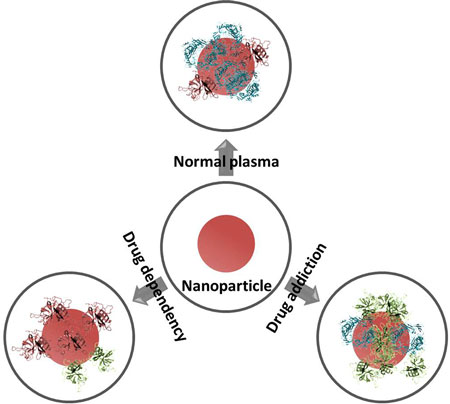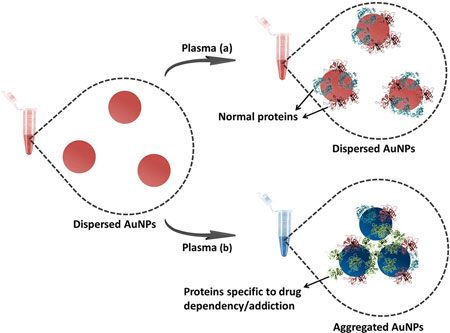| Posted: Jun 01, 2018 | |
Potential nanotechnology applications in combating opioid drug abuse |
|
| (Nanowerk Spotlight) Opium has been used and abused for centuries, but recent opioid abuse statistics paint a scary picture. In the U.S. alone, the latest figures (which are likely to be underreported) from October 2017 show 68,400 annual overdose deaths. | |
| The three most important opiates, legally prescribed as pain killers, are morphine, codeine (which has been used as a cough remedy) and thebaine, which is further refined by chemical processes to create higher-value therapeutics such as oxycodone and hydrocodone, better known by brand names such as OxyContin and Vicodin, respectively. | |
| "Drug abuse and dependence/addiction are complex disorders that are regulated by a wide range of interacting networks of genes and pathways that control a variety of phenotypes," Morteza Mahmoudi, an instructor of the Department of Anesthesiology at Brigham and Women's Hospital and Harvard Medical School, tells Nanowerk. "Therefore, both identification of the at-risk population and treatment of the addiction disorders are strongly reliant on the development of new and innovative approaches for understanding the mechanisms underlying drug dependency and addiction." | |
| A new Perspective article in ACS Chemical Neuroscience ("Drug-Abuse Nanotechnology: Opportunities and Challenges"), first-authored by Mahmoudi, introduces possible potential capacities of nanotechnology and shines more light by providing knowledge to the field of drug dependency and addiction. | |
| Whereas nanotechnologies are widely researched for medical applications, their potential application in drug abuse – diagnostic, drug detoxification, and therapeutic application – is poorly investigated. | |
| "When searching the literature, there are fewer than expected reports on developing nanotechnologies for the treatment of drug abuse, detecting drugs in human urine and saliva, reducing the toxic concentrations of drugs in blood, and also for probing the effect of drug abuse on biochemical or structural variations of brain tissue," Mahmoudi points out. | |
| He notes that the development of new and innovative approaches for understanding the mechanisms underlying addiction is of crucial importance in the field of opioid drug abuse. Novel nanotechnology approaches may lead to 1) identification of at-risk individuals in the population; 2) new therapeutic targets; and 3) personalized selection of appropriate treatments. | |
 |
|
| Scheme showing differences in the biomolecular corona structures after interaction of nanoparticles with plasma of healthy individuals and people with a risk of drug dependency and patients with drug addiction disorders. The changes in the biomolecular corona structures can be driven by variations of plasma protein and metabolomic compositions of healthy, at-risk, and drug addiction disorder individuals. (Reprinted with permission by American Chemical Society) | |
| In their paper, Mahmoudi and co-authors Sepideh Pakpour and George Perry draw attention to the potential role of nanotechnologies in several areas: | |
| Drug addiction therapy: Nanotechnologies can be designed and engineered to regulate brain signaling pathways that are associated with drug addiction. This particular approach needs development of multifunctional nanoparticles that have a unique capacity to transmigrate across blood brain barrier and target the desired site of the brain. | |
| A better understanding of brain anatomical changes: Opioid drugs demonstrated a great capacity in altering important brain areas. These anatomic functional variations can alter biochemistry balance of the brain and affect many of the brain's critical functions, including problem solving, decision making, and rewarding circuit system. Real-time monitoring of particular neurotransmitters and brain anatomical changes using highly sensitive approaches is of great importance to shed more light on the mechanistic role of drug abuse on brain functions. | |
| Enhanced sensitivity of drug detection approaches: The use of engineered nanoparticles can substantially enhance identification and discrimination capacity of healthy, at-risk populations and addiction patients in a short period of time with reliable and reproducible outcomes. Although nanotechnologies showed great potential in overcoming the issues of conventional drug monitoring approaches, their usage for this purpose is poorly investigated. | |
 |
|
| Scheme showing possible role of substance abuse biomolecular corona in changing the color of colloidal nanoparticles which may be used for development of cheap, fast, and reliable biosensors for identification of substance abuse disorder. (Reprinted with permission by American Chemical Society) | |
| Microbiome-gut-brain axis: Exploring and understanding the relationship between gut bacteria and drug addiction is still in its infancy, and in-depth studies are required to better understand and define the mechanisms involved in opioid addiction and dependency. It appears, though, that changes in the gut microbiota can affect opioid tolerance in the cell bodies of extrinsic sensory neurons. The microbiome can also play a role in the development of opioid tolerance and alter important synaptic transcripts in the brain's reward circuitry. Therefore, it is legitimate to hypothesize that nanotechnologies-facilitated manipulation of gut microbiota profiles may have a capacity to minimize adverse effects of drug abuse. | |
| Monitoring blood plasma variations: Proteomic characterization of blood plasma is of central importance to possible biomarker discovery studies. However, advances in the fields of proteomics and genomics have not yet translated into a workable platform for either the development of suitable drugs to identify at-risk populations or diminishing the risk of addictive relapse. This is largely due to the fact that no individual plasma protein is specific and sensitive enough to identify the source of its corresponding genetic variation and gene-gene interactions, and appropriate technology platforms for accurate and sensitive multivariate plasma analysis relevant to opioid drug addiction have remained elusive. | |
| "One of the central reason for the limited use of nanotechnologies in drug-abuse applications is the lack of investment from government and foundations in the field of drug-abuse nanotechnology" notes Mahmoudi. "Therefore, we believe that specific funding for drug-abuse nanotechnology should be established and substantially increased to empower the use of nanotechnologies in the field, which may pave a way for emerging of breakthrough discoveries for diagnosis and therapeutic applications in drug abuse." | |
| "With the help of funding agencies together with establishment of collaborations between nanomedicine and drug-abuse experts, we believe that nanotechnologies will provide a unique capacity for both predictive and therapeutic approaches in opioid dependency and addiction in the foreseeable future," he concludes. | |
 By
Michael
Berger
– Michael is author of three books by the Royal Society of Chemistry:
Nano-Society: Pushing the Boundaries of Technology,
Nanotechnology: The Future is Tiny, and
Nanoengineering: The Skills and Tools Making Technology Invisible
Copyright ©
Nanowerk LLC
By
Michael
Berger
– Michael is author of three books by the Royal Society of Chemistry:
Nano-Society: Pushing the Boundaries of Technology,
Nanotechnology: The Future is Tiny, and
Nanoengineering: The Skills and Tools Making Technology Invisible
Copyright ©
Nanowerk LLC
|
|
|
Become a Spotlight guest author! Join our large and growing group of guest contributors. Have you just published a scientific paper or have other exciting developments to share with the nanotechnology community? Here is how to publish on nanowerk.com. |
|
